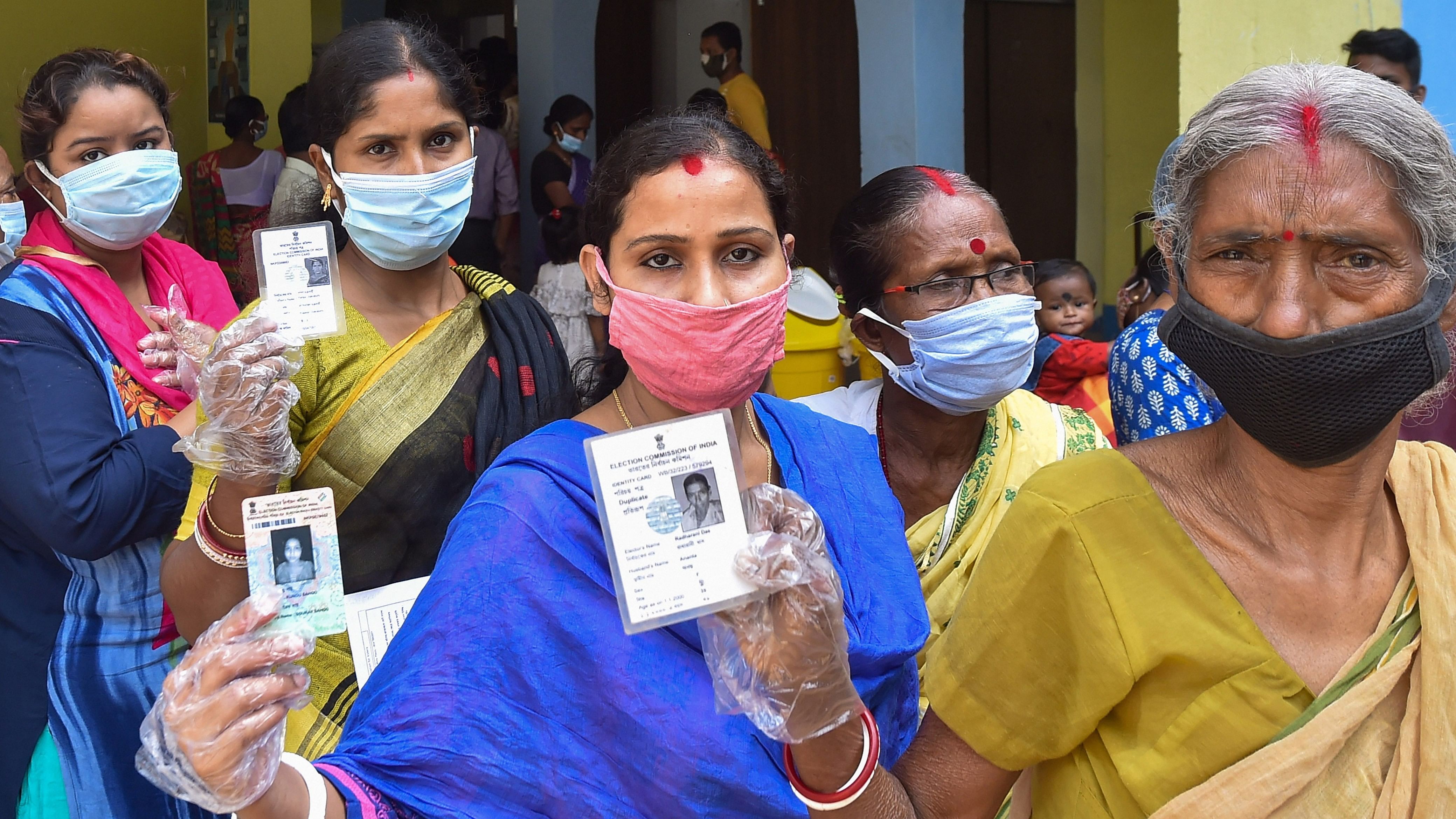
A file photo of women showing their identity cards.
Credit: PTI photo
Kolkata: With cohesive voting patterns and higher turnout compared to men in recent elections, women voters, constituting nearly 50 per cent of West Bengal's electorate, have become a pivotal voting bloc that all political parties are vying to woo ahead of the parliamentary polls.
According to the latest data from the Election Commission, the state has 3.73 crore women voters, 12 lakh less than the number of registered male voters at 3.85 crore.
However, there has been a notable increase in the registration of fresh women voters, with their numbers growing by 9.8 per cent between 2019 and 2024.
Interestingly, in the 2019 Lok Sabha polls, women recorded a higher voter turnout than men, with 81.79 per cent of women casting their votes compared to 81.35 per cent of men.
Data showed that in the 2019 elections, women registered a higher turnout than men in 17 of the 42 Lok Sabha seats in the state.
According to the Election Commission data, the state now has 968 female voters for every 1,000 male voters. This showed a considerable rise from 2019, when the number was 949, and grew in 2021 to 961 for every 1,000 male voters.
Political analysts pointed out that while women voters have traditionally been loyal supporters of the TMC, along with minorities who make up around 30 per cent of the electorate, the BJP tasted limited success in wooing women voters, although making significant inroads in SC-ST reserved seats in 2021 assembly polls.
They said that the TMC has the advantage of having a woman, Mamata Banerjee, at its helm, who has garnered the support of women, especially from marginalised backgrounds, throughout her political career, while the state BJP lacks popular women faces.
Senior BJP leader and MLA Agnimitra Paul acknowledged the fact that the state unit faced challenges in gaining traction among women voters, despite the Centre's popular schemes such as the Ujjwala Scheme and Swachh Bharat Mission.
"It is evident that we haven't always effectively communicated our message at the grassroots level to gain the trust of women voters. However, in certain areas, women showed enthusiastic support for us in the 2021 elections. We believe that given the visibility of atrocities against women, they will vote for us this time," she told PTI.
TMC's Leader of the Parliamentary Party in Rajya Sabha, Derek O'Brien, on the other hand, alleged that the BJP-RSS ideology is not aligned with women's empowerment.
"When the BJP seeks women's votes, we must remind them that they are a party created on the ideology of the RSS. Are women even allowed into an RSS shakha? 'That's why I am not surprised that the BJP Lok Sabha MP who sexually harassed our champion women wrestlers continues to be pampered by Narendra Modi and his boys," O'Brien told PTI.
A glance at the voting pattern in the 2019 elections showed that in 17 out of the 42 Lok Sabha seats, women recorded a higher turnout than men.
In these seats, the TMC emerged victorious in eight, the BJP in seven, and the Congress in two. In seven of these seats, the difference in turnout between women and men was more than five per cent. In Malda North, this gap was as high as 7.79 per cent.
Women voters outnumbered men in only one Lok Sabha seat in the state, Dum Dum.
In Cooch Behar, Jalpaiguri, Murshidabad, Ranaghat, Krishnangar, Bardhaman Purba, Bolpur, Bishnupur, Jhargram, Kanthi, Tamluk, Ghatal, Bishnupur seats, women voting percentage was above 85 per cent, and much higher than that of men.
Political analysts categorised the women voter bloc in the state into four sub-categories: minority, general, subaltern and SC-ST women.
In the 2021 assembly elections, the TMC secured more than 50 per cent of the women's votes, while the BJP garnered 37 per cent. The saffron party also made significant inroads into the SC-ST women's voting bloc, particularly performing well in the reserved seats.
Chandrima Bhattacharya, state Finance Minister and TMC women wing's president, stated that unlike the BJP, her party does not view women as merely a 'voting bloc'.
"We didn't introduce popular schemes with elections in mind, we genuinely believe in empowering women, both socially and economically. Our chief minister, being a woman herself, understands the challenges faced by women," she told PTI.
The TMC government has implemented schemes such as Rupashree, which assists with wedding expenses, Kanyashree that provides financial aid to girls, and Lakshmir Bhandar, offering monthly cash transfers to female heads of households.
In the 2024-25 budget, 44 per cent of resources were dedicated to women empowerment initiatives.
Economist Saswati Ghosh attributed the TMC's popularity among women voters in the state to the 'Didi effect', referring to Mamata Banerjee, along with the implementation of women-centric policies aimed at economic and social empowerment.
"There is a Didi effect among voters, especially women. Also, women-centric policies for economically and socially empowering them have helped the TMC win them over," she said.
Women rights activist Bolan Gangopadhyay said that economic empowerment has enabled women to make their own decisions, including choosing which party to vote for.
"Till a few decades back, it was the man of the house who decided how the women in the family would vote. But now, women are more economically empowered. The TMC's policies have played a significant role in economically empowering women, particularly in rural areas," she said.
Political analyst Suman Bhattacharya noted that despite the BJP's efforts to consolidate the SC-ST vote bank, Mamata Banerjee continued to maintain influence over the Bengali women voter base.
"One of the main reasons behind this is that Bengal BJP doesn't have popular women leadership to counter Mamata Banerjee's charisma and the BJP's brand of politics doesn't connect with the Bengalis," he said.